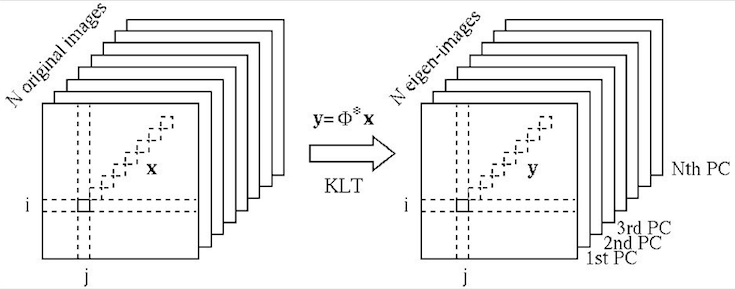A set of ![]() images of
images of ![]() rows and
rows and ![]() columns and
columns and ![]() pixels
can be represented as a K-D vector by concatenating its
pixels
can be represented as a K-D vector by concatenating its ![]() columns (or
its
columns (or
its ![]() rows), and the
rows), and the ![]() images can be represented by a
images can be represented by a ![]() array
array ![]() with each column for one of the
with each column for one of the ![]() images:
images:
![\begin{displaymath}
{\bf X}_{K\times N}
=[{\bf x}_{c_1},\cdots,{\bf x}_{c_N}]
...
...
({\bf X}^T)_{N\times K}=[{\bf x}_{r_1},\cdots,{\bf x}_{r_K}]
\end{displaymath}](img202.png)
A KLT can be applied to either the column or row vectors of the data
array ![]() , depending on whether the column or row vectors are
treated as the realizations (samples) of a random vector.
, depending on whether the column or row vectors are
treated as the realizations (samples) of a random vector.
![\begin{displaymath}
{\bf\Sigma}_r=\frac{1}{K}\sum_{i=1}^K{\bf x}_{r_i}{\bf x}^T...
...x}_{r_K}^T\end{array}\right]
=\frac{1}{K} ({\bf X}^T{\bf X})
\end{displaymath}](img209.png)

Pre-multiplying ![]() on both sides of the eigenequation above we
get
on both sides of the eigenequation above we
get
![\begin{displaymath}
{\bf\Sigma}_c=\frac{1}{N} \sum_{i=1}^N{\bf x}_{c_i}{\bf x}^...
...f x}_{c_K}\end{array}\right]
=\frac{1}{N} ({\bf X}{\bf X}^T)
\end{displaymath}](img231.png)
![\begin{displaymath}
{\bf z}_{c_j}={\bf V}^T{\bf x}_{c_j}
=\left[\begin{array}{...
...K^T\end{array}\right]
{\bf x}_{c_j},\;\;\;\;\;(j=1,\cdots,N)
\end{displaymath}](img238.png)
![\begin{displaymath}
{\bf x}_{c_j}={\bf V}{\bf z}_{c_j}
=[{\bf v}_{c_1},\cdots...
...dots z_K\end{array}\right]
=\sum_{i=1}^K z_i {\bf v}_{c_i}
\end{displaymath}](img242.png)
From these two cases we see that the eigenvalue problems associated with
these two different covariance matrices
![]() and
and
![]() are equivalent, in the sense that they
have the same non-zero eigenvalues, and their eigenvectors are related by
are equivalent, in the sense that they
have the same non-zero eigenvalues, and their eigenvectors are related by
![]() or
or
![]() . We can therefore
solve the eigenvalue problem of either of the two covariance matrices,
depending on which has lower dimension.
. We can therefore
solve the eigenvalue problem of either of the two covariance matrices,
depending on which has lower dimension.
Owing to the nature of the KLT, most of the energy/information contained
in the ![]() images, representing the variations among all
images, representing the variations among all ![]() images, is
concentrated in the first few eigen-images corresponding to the greatest
eigenvalues, while the remaining eigen-images can be omitted without
losing much energy/information. This is the foundation for various
KLT-based image compression and feature extraction algorithms. The
subsequent operations such as image recognition and classification can
be carried out in a much lower dimensional space after the KLT.
images, is
concentrated in the first few eigen-images corresponding to the greatest
eigenvalues, while the remaining eigen-images can be omitted without
losing much energy/information. This is the foundation for various
KLT-based image compression and feature extraction algorithms. The
subsequent operations such as image recognition and classification can
be carried out in a much lower dimensional space after the KLT.
In image recognition, the goal is typically to classify or recognize some
image objects of interest, such as hand-written alphanumeric characters,
and human faces, represented in image forms. Obviously not all pixels in
an image are relevant to the representation of the object, the KLT can be
carried out to compact most of the information into a small number of
components. Specifically,
Here the ![]() transform matrix is composed of the
transform matrix is composed of the ![]() eigenvectors
corresponding to the
eigenvectors
corresponding to the ![]() greatest eigenvalues of the covariance matrix
greatest eigenvalues of the covariance matrix
![]() :
:
Example
![\begin{displaymath}
{\bf X}=\left[\begin{array}{cc}4&8\ 6&8\ 1&3\ 9&6\end{array}\right]
\end{displaymath}](img256.png)
![\begin{displaymath}
{\bf\Lambda}=\left[\begin{array}{cc}15.12&0\ 0&291.88\end{a...
...1710\\
-0.2179 & 0.1919 & -0.7369 & 0.6105\end{array}\right]
\end{displaymath}](img257.png)
![\begin{displaymath}
{\bf Y}=\left[\begin{array}{rr}
0.0000 & 0.0000\\
0.0000...
...0\\
-2.9368 & 2.5484\\
11.1971 & 12.9037\end{array}\right]
\end{displaymath}](img258.png)